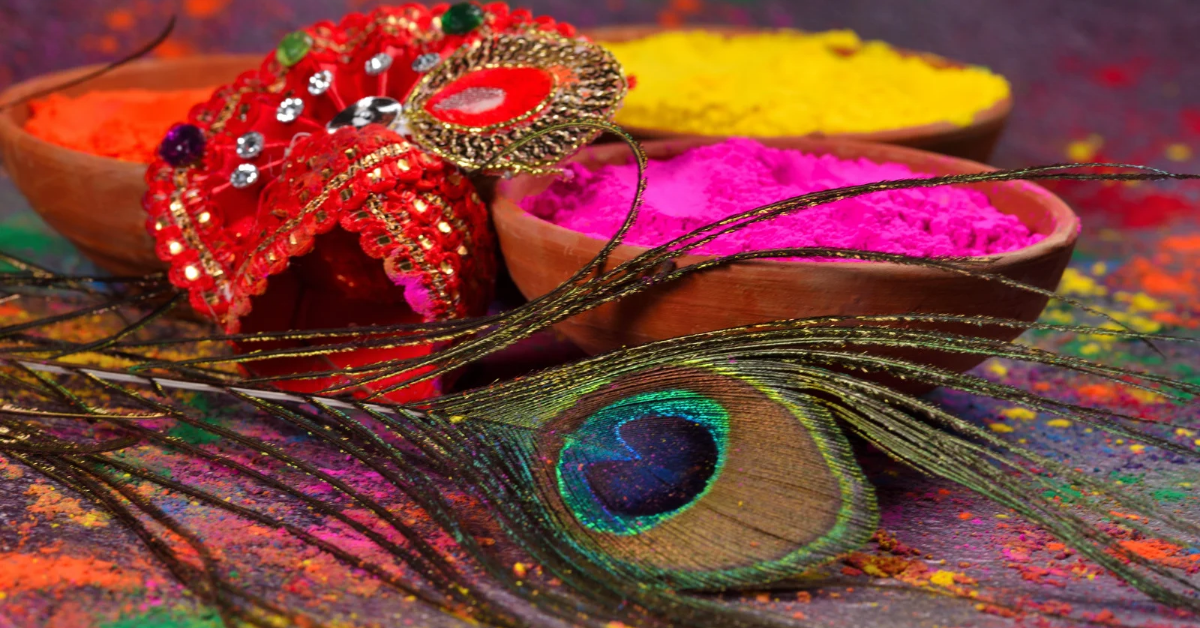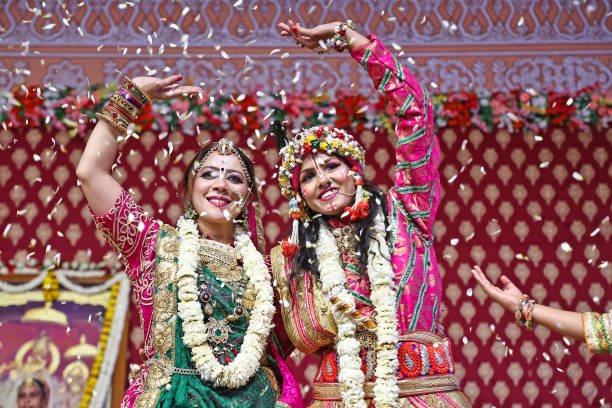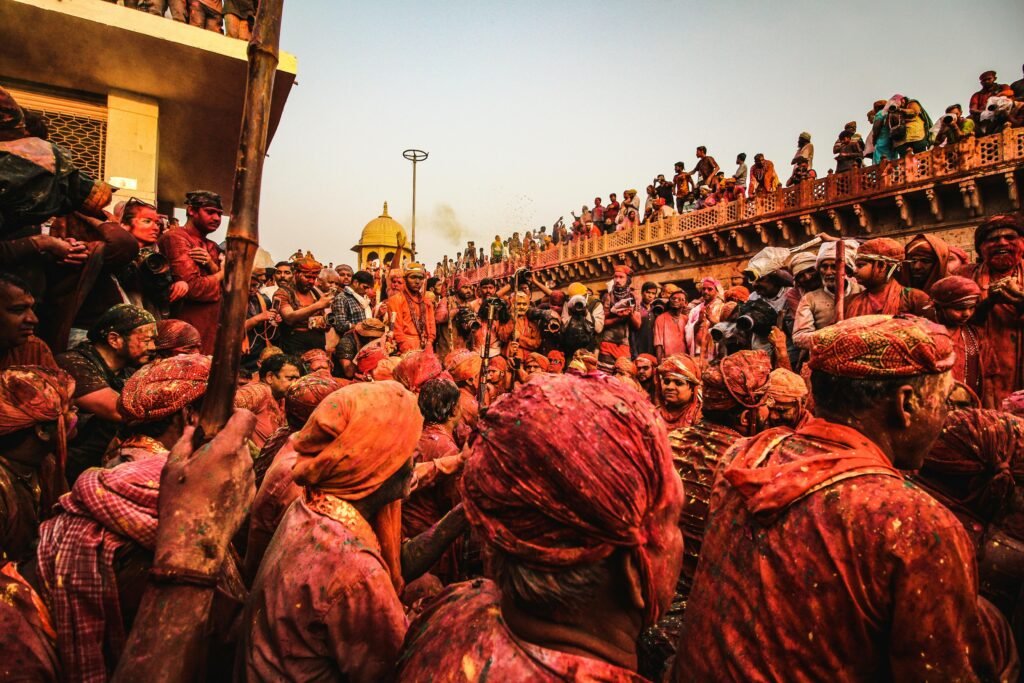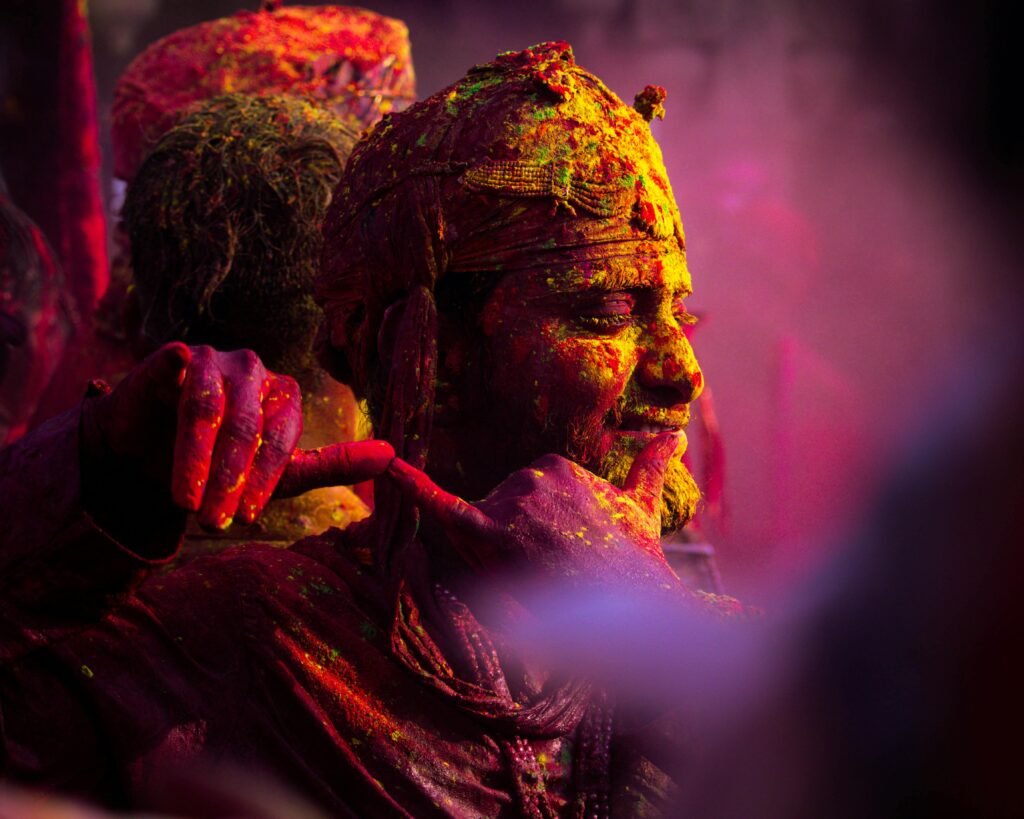
Introduction to Holi and its Mythological Roots
Holi isn’t just about throwing colors and dancing to festive beats—it carries centuries of mythological significance. Rooted in Hindu traditions, Holi temple traditions revolve around divine legends, devotion, and symbolic rituals. It celebrate love, faith, and victory over evil. From Krishna’s playful mischief to Prahlada’s unwavering devotion, Holi embodies stories that inspire millions every year.
From Vrindavan and Barsana, where Lord Krishna and Radha’s leela’s gave birth to the joyous Lathmar Holi. Krishna, playfully smeared colors on Radha and her friends, setting the stage for a tradition that still fills the temples of Banke Bihari and Radha Rani Mandir with song, dance, and devotion. If you visit these temples during Holi, you’ll witness not just colors but divine love in motion.
Equally significant is the tale of Holika Dahan, which represents the victory of faith over arrogance. Devotees gather at temples like Shri Prahladeshwar Mahadev Mandir in Varanasi. They light bonfires to honor Prahlada’s devotion and Lord Vishnu’s divine protection.
These Holi temple traditions bring ancient mythology to life, turning temples into living symbols of faith, color, and celebration.
The Historical Origins of the Holi Festival

Holi isn’t just a festival of colors—it’s a celebration deeply rooted in ancient Hindu traditions and mythology. From temple rituals to mythological tales, Holi’s origins date back thousands of years, evolving into a grand expression of divine love, faith, and the victory of good over evil. Across India, temple Holi traditions keep these legends alive, blending spiritual devotion with playful festivities.
Ancient Texts and the First Mentions of Holi
The earliest references to Holi can be found in sacred Hindu texts like the Vedas, Puranas, and Mahabharata. Holi, once known as Holika or Holikotsav,was a seasonal festival marking the arrival of spring, encouraging social harmony and renewal. Jaimini’s Purvamimamsa-Sutras and Kathaka-Grhya-Sutras also describe Holi-like rituals, where people smeared natural colors on each other, gathered for songs, and rejoiced in community celebrations.
Mathura and Vrindavan showcase spectacular Holi temple traditions. Lord Krishna’s legendary Holi comes to life in these sacred cities. The Banke Bihari Temple hosts Phoolon ki Holi. Priests shower devotees with fragrant flower petals instead of colors. This tradition recreates Krishna’s playful leelas with Radha.
The Legend of Holika Dahan and its Temple Connection
One of Holi’s most significant rituals, Holika Dahan, dates back to the story of Prahlada, the devoted child of demon king Hiranyakashipu. When his father sought to destroy his unwavering faith in Lord Vishnu, Prahlada’s wicked aunt Holika lured him into a fire, believing her divine boon would keep her safe. However, her ill intentions backfired, and she perished while Prahlada emerged unscathed, symbolizing the victory of devotion over evil.
The legend is honored with grand Holika Dahan ceremonies. Shri Prahladeshwar Mahadev Mandir in Varanasi holds special rituals. Bonfires are lit as a spiritual reminder. They symbolize that righteousness always triumphs over evil. chant prayers, offering coconut and wheat as symbols of purity and gratitude.
Temple Holi Traditions and the Treta Yuga Connection
Holi’s history also extends into the Treta Yuga, the era of Lord Rama. Devotees believe that during his exile, Lord Rama and Sita played Holi with natural colors, spreading joy despite their hardships. While historical proof is scarce, temples dedicated to Rama, like Ayodhya’s Hanuman Garhi, still celebrate Holi with bhajans, processions, and sacred color play.
From age-old scriptures to temple festivities, temple Holi traditions continue to preserve Holi’s divine essence. Vrindavan celebrates Holi with fragrant flower petals. Varanasi honors it with sacred fire rituals. Ayodhya resonates with spiritual chants. Each temple shares a unique Holi story. This makes Holi more than just a festival.
Holi and the Divine Leelas of Radha and Krishna
Holi is not just about colors; it is a sacred celebration of divine love and playful devotion. In Vrindavan and Mathura, the festival is deeply intertwined with the leelas of Radha and Krishna, making temple Holi traditions an experience like no other. These traditions recreate the joy, mischief, and spiritual beauty of Krishna’s legendary Holi celebrations, bringing devotees closer to the divine.
Radha and Krishna: The Essence of Vrindavan’s Temple Holi Traditions
The legend of Holi dates back to Lord Krishna’s childhood in Gokul, where he was known for his mischievous pranks. As a young boy, Krishna often felt envious of Radha’s fair complexion, wondering why he was dark-skinned while she shone like gold. Playfully, his mother Yashoda suggested he apply color on Radha’s face, sparking what is now the world’s most colorful festival.
In Vrindavan’s Banke Bihari Temple, this playful moment is relived through Phoolon ki Holi, where devotees are showered with fragrant flower petals. This unique tradition symbolizes divine love in its purest form, allowing devotees to feel the bliss of Krishna’s playful leelas. The Dwarkadhish Temple in Mathura hosts a grand Holi celebration. The deity is adorned in vibrant colors. Devotees sing bhajans with devotion. They reenact the joy of Krishna’s Holi with enthusiasm.
Lathmar Holi and Braj: Tradition Meets Mythology
One of the most fascinating temple Holi traditions unfolds in Barsana and Nandgaon, villages near Mathura. Here, Lathmar Holi is celebrated with playful rivalry, inspired by an age-old legend. It is believed that Krishna and his friends would visit Radha’s village, Barsana, teasing the gopis (cowherd maidens). In response, the women, led by Radha, would chase Krishna and his friends away using sticks (lathis).
Today, this tradition continues at the Radha Rani Temple in Barsana, where men from Nandgaon try to smear color on the women, only to be met with a rain of playful stick blows. The event is filled with laughter, music, and devotion, showing that Holi is not just a festival but a reenactment of divine stories.
Temple Holi Traditions: A Celebration of Divine Love
From Mathura’s grand Holi celebrations to Barsana’s playful rivalry, temple Holi traditions keep Krishna’s divine leelas alive. Devotees immerse themselves in color, bhajans, and dance, experiencing the joy, devotion, and spirituality that define Holi. Whether you are drenched in petals at Vrindavan’s temples or playfully dodging sticks in Barsana, every moment of Holi brings you closer to the divine spirit of Radha and Krishna’s eternal love.
Phoolon ki Holi: A Divine Celebration of Flowers at Banke Bihari Temple
Holi in Vrindavan is a truly magical experience, where temple Holi traditions blend devotion, mythology, and celebration. Among the many vibrant rituals, one of the most enchanting is Phoolon ki Holi, a festival where flowers replace colors to create a breathtaking display of devotion and beauty. Celebrated at the revered Banke Bihari Temple, this unique tradition brings Radha and Krishna’s divine love to life, filling the air with joy, fragrance, and spirituality.
A Spiritual Take on Holi: Flowers Instead of Colors
Unlike the usual color-filled celebrations, Phoolon ki Holi offers a softer, more divine way to experience the festival. Hindu legends say Krishna and Radha once played Holi with flowers. They enjoyed nature’s beauty in Vrindavan’s blooming forests. Today, this tradition is revived every year. Temple priests shower devotees with vibrant petals. The temple fills with the fragrance of roses, marigolds, and jasmine.
This grand celebration takes place on Ekadashi, just a few days before Holi, and lasts for only 15-20 minutes. But in that short time, the temple becomes a divine paradise. Devotees sing bhajans with devotion. They dance joyfully in celebration. Krishna’s eternal pastimes come to life.
Temple Holi Traditions: A Celebration of Love and Devotion
Phoolon ki Holi is not just visually mesmerizing; it carries a deep spiritual meaning. The use of flowers reflects Vrindavan’s pure and natural traditions, reminding devotees of the harmony and divine love that Holi represents. Unlike chemical colors, flowers are gentle on the skin and symbolize peace, purity, and devotion.
As you stand in Banke Bihari Temple, petals shower over you. You feel connected to a timeless tradition. Temple Holi is more than just playing with colors. It is about immersing yourself in divine love. The festival celebrates Krishna’s playful and blissful leelas.
Temple Holi Traditions: Unique Regional Celebrations of Holi in India
Holi is one of India’s most joyous and vibrant festivals. Every region celebrates it in a unique way. Some places are known for temple Holi traditions. Others include local folklore, dance, and cultural flavors. Vrindavan and Mathura celebrate Holi with playful traditions. Goa’s grand Shigmo festival adds its own charm. Each region gives Holi a special touch.
Mathura & Vrindavan: The Sacred Heart of Temple Holi Traditions
Mathura and Vrindavan, the birthplace and playground of Lord Krishna, are the most spiritually significant places to celebrate Holi. The Holi festival here lasts for days, blending devotion, colors, and joy into a divine spectacle.
Lathmar Holi (Barsana & Nandgaon): Inspired by the legend of Radha and Krishna, women playfully chase and hit men with sticks, while men try to drench them in colors.
Phoolon ki Holi (Banke Bihari Temple): Instead of powders, Holi is celebrated with showers of fragrant flower petals, creating a divine and peaceful ambiance.

Widows’ Holi (Vrindavan): A recent addition to temple Holi traditions, this heartwarming celebration allows widows to break social taboos and join in the festivities.
Shigmo in Goa: A Blend of Holi and Hindu FolkloreIn Goa, Holi transforms into Shigmo, a spring festival of dance, music, and mythological processions. Unlike the color-centric Holi of the North, Shigmo focuses on Goa’s Hindu traditions.
Grand Mythological Floats: Shigmo parades feature elaborate floats depicting stories from the Ramayana and Mahabharata, merging Holi with Hindu storytelling.
Traditional Folk Dances: Goa’s Romta Mel and Metam dances, performed in vibrant costumes, showcase the state’s unique cultural blend.
Musical Celebrations: The festival pulses with drumming, temple processions, and folk songs, keeping ancient temple Holi traditions alive.
Holi in Rajasthan: A Royal Affair
Rajasthan celebrates Holi with a mix of royal grandeur and temple traditions, making it one of the most unique Holi experiences in India.
Mewar Holika Dahan: In Udaipur’s City Palace, the royal family lights the traditional Holika pyre, continuing an age-old ritual.
Elephant Festival (Jaipur): A magnificent parade of decorated elephants, followed by color play, marks a majestic Holi celebration.
Braj Holi (Bharatpur): Similar to Vrindavan, Holi in Bharatpur’s temples is deeply rooted in Krishna’s spiritual and playful legends.
The Absence of Holi in Kerala
Interestingly, while Holi is widely celebrated across India, it is not a major festival in Kerala. The reasons are deeply cultural and seasonal.
Local Festival Dominance: Kerala’s Onam and Vishu are more prominent and overshadow Holi in cultural importance.
Agricultural Timing: Unlike North India, Kerala’s harvest seasons do not align with Holi’s spring festival timing.
Urban Influence: While rural Kerala remains untouched, cities like Kochi and Thiruvananthapuram have started hosting small Holi events.
Temple Holi Traditions: A Celebration of Spirituality and Culture
From Krishna’s divine Holi in Vrindavan to Goa’s mythological Shigmo festival, temple Holi traditions connect us to India’s rich spiritual heritage. Whether celebrated with colors, flowers, or grand parades, Holi remains a festival that unites communities, honors legends, and spreads divine joy.
The Mythological Connection Between Temples and Holi
Holi has its roots in ancient Hindu legends, particularly those of Lord Krishna, Radha, and Prahlada. In Vrindavan and Mathura, where Krishna spent his childhood, Holi is celebrated as a reenactment of his playful leelas (divine pastimes). Meanwhile, the tradition of Holika Dahan—the burning of an effigy on Holi eve—symbolizes the triumph of Prahlada’s unwavering devotion over his tyrannical father, Hiranyakashipu
Temples honor these stories by hosting grand celebrations filled with music, dance, and rituals. Devotees gather to sing bhajans, throw gulal (colored powder), and participate in age-old traditions that bring these legends to life.
Famous Temples That Celebrate Holi with Grandeur
Banke Bihari Temple, Vrindavan: Holi here is an immersive spiritual experience, where the deity is adorned with vibrant colors, and flowers rain down on devotees in a unique tradition called Phoolon ki Holi.
Dwarkadhish Temple, Mathura: This temple hosts elaborate processions and devotional gatherings, echoing the playful Holi celebrations of Krishna and the gopis.
ISKCON Temples Across India: Here, Holi takes on a devotional touch, with joyous kirtans, dance, and color play, making it a soulful experience for Krishna devotees.
Temple Holi Traditions: Where Spirituality Meets Celebration
Holi in temples is not just about throwing colors—it’s a spiritual journey. Whether you’re celebrating in the narrow lanes of Vrindavan or at an ISKCON temple chanting the holy names, Holi connects you to divine love, devotion, and centuries-old traditions that still shine bright today.
Temple Holi Traditions: Mythological Significance of Temples in Holi Festivities
Holi is more than just a riot of colors—it carries deep mythological significance, especially when celebrated in temples.These sacred spaces are more than places of worship. They symbolize divine stories and ancient traditions. Holi’s essence unfolds through rituals and devotional songs. Grand festivities bring these traditions to life. Krishna and Radha’s playful love is celebrated with joy. Prahlada’s tale represents the triumph of faith. Every temple Holi tradition carries a deep spiritual legacy. This legacy has been preserved for centuries.
Krishna’s Playful Holi: A Celebration of Love and Devotion
No discussion of Temple Holi Traditions is complete without mentioning Lord Krishna, the playful deity who made Holi an expression of love and devotion. According to Hindu mythology, Krishna, mischievous and full of life, was worried about his dark complexion and playfully smeared colors on Radha’s face to make them equals. This act became the foundation of Holi’s vibrant celebrations, particularly in Braj—the land of Krishna.
Even today, the Banke Bihari Temple in Vrindavan keeps this tradition alive. It celebrates Phoolon ki Holi with fragrant petals. Devotees are showered with flowers instead of colored powders. This serene celebration reflects Radha and Krishna’s pure love. The temple fills with music, devotion, and vibrant colors.
Holika Dahan: Burning Away Negativity
Holi isn’t just about playful colors—it also carries a deeper message of victory over evil. The night before the colorful revelry begins, temples across India hold Holika Dahan, a sacred bonfire ritual that recalls the story of Prahlada and the demoness Holika.
Legend tells of King Hiranyakashipu, who despised his son Prahlada’s devotion to Lord Vishnu. His sister, Holika, tricked Prahlada into sitting on a fire, believing her immunity to flames would protect her. But divine intervention saved Prahlada, while Holika was reduced to ashes. This story reminds you that faith in the divine always triumphs, and many temples mark this event by lighting bonfires, symbolizing the burning away of negativity before Holi’s joyous celebrations begin.
Temples as the Spiritual Heart of Holi
During Holi, temples become vibrant centers of devotion, where people gather to sing bhajans, chant the names of deities, and rejoice in the festival’s divine origins. In Mathura’s Dwarkadhish Temple, Holi is celebrated with grandeur, with priests and devotees smearing colors on each other while singing praises of Krishna’s childhood leelas.
Even ISKCON temples worldwide mark Holi with kirtans, spiritual discourses, and bursts of color, reminding everyone that Holi is not just a festival but a sacred experience of unity, joy, and devotion.
Whether you find yourself dancing in Vrindavan, participating in a temple procession in Mathura, or chanting bhajans in an ISKCON hall, one thing is certain—Temple Holi Traditions keep the spiritual essence of Holi alive, connecting you to the divine in the most colorful way possible!
Temple Holi Traditions , Mythology & Cultural Questions
Holi is more than just a festival of colors—it’s a celebration deeply rooted in mythology and tradition. Across India, different regions have unique ways of celebrating, shaped by local legends, historical influences, and spiritual practices. Temple Holi Traditions play a central role, making this festival a vibrant blend of devotion, history, and joy.
Multan’s Forgotten Holi Legacy
Long before modern borders, Holi was celebrated in Multan, now in Pakistan. This ancient city, known as the “City of Saints,” holds a deep connection to Holika Dahan. According to legend, Vishnu saved Prahlada, a devoted follower, from his father Hiranyakashipu’s wrath. Holika, Prahlada’s aunt, perished in a divine fire while trying to harm him. event, symbolizing the triumph of good over evil, remains one of Holi’s most sacred traditions. Multan no longer widely observes Holi. However, its history reminds you how deeply the festival is woven into the subcontinent’s spiritual fabric.
North vs. South: A Colorful Contrast
Holi celebrations in North and South India vary greatly. In the North, Holi is an explosion of color, music, and tradition. You can witness Lathmar Holi in Barsana, where women playfully chase men with sticks, reenacting Radha’s playful dominance over Krishna. At the Banke Bihari Temple in Vrindavan, Phoolon ki Holi fills the air with fragrant flower petals, turning the temple into a divine paradise.
In contrast, South India’s Holi traditions lean towards spiritual observances. Temples hold prayers, cultural performances, and rituals that honor the changing seasons. In Goa, the Shigmo festival combines Holi’s spirit with grand parades and folk dances, celebrating warriors’ victories from Hindu epics.
Mythological Connections: A Universal Celebration
Some historians draw parallels between Hercules and Krishna, both known for their divine strength and heroism. Krishna’s playful Holi celebrations in Braj echo stories of gods worldwide, uniting cultures through shared legends of love, courage, and celebration. Temple Holi Traditions not only bring people together but also connect past and present, making Holi a festival that transcends time and geography.
Conclusion: Holi’s Enduring Legacy in Indian Mythology & Culture
Holi is more than just a festival of colors—it is a beautiful blend of mythology, devotion, and cultural heritage. Across India, temple Holi traditions bring alive the legends of gods and goddesses, making every celebration a divine experience. From the flower-laden Phoolon ki Holi in Vrindavan’s Banke Bihari Temple to the grand Lathmar Holi in Barsana, each tradition tells a sacred story passed down through generations.
In Braj, Holi is incomplete without Krishna and Radha’s playful leelas, celebrated with immense devotion. The Banke Bihari Temple is famous for its floral Holi. Petals replace powdered colors, creating a mesmerizing sight. Barsana and Nandgaon celebrate Lathmar Holi. Women playfully tease men with sticks. This tradition reenacts Radha’s playful teasing of Krishna. Men try to shield themselves from the playful strikes.
These temple Holi traditions are not just rituals; they are living expressions of love, faith, and unity. Whether you find yourself amidst Vrindavan’s vibrant festivities or witnessing the spiritual fervor of Mathura, Holi continues to connect you with India’s timeless traditions. So next time you throw a handful of colors, remember—you are celebrating history, devotion, and the joyous spirit of the divine!


